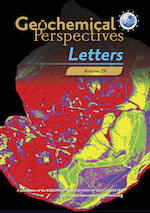182W evidence for core-mantle interaction in the source of mantle plumes
Affiliations | Corresponding Author | Cite as | Funding information- Share this article





Article views:14,276 - In the top 10Cumulative count of HTML views and PDF downloads.
- Download Citation
- Rights & Permissions
top
Abstract
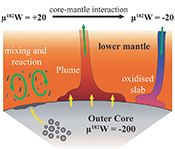
Figures and Tables
 Table 1 Tungsten isotope results for rock samples from the Pilbara Craton, the Kerguelen Archipelago, Réunion Island and the Hawaiian basalt BHVO-2. | 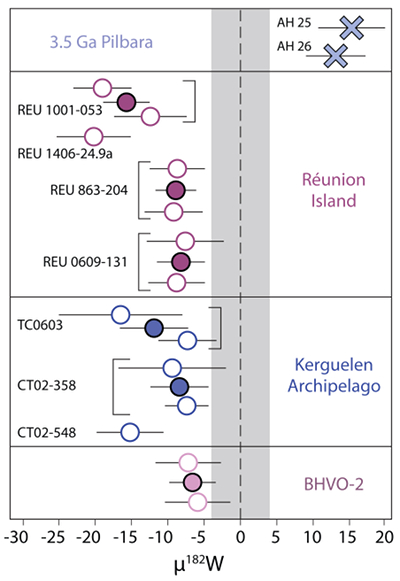 Figure 1 182W/184W data obtained in this study shown as µ182W values. Open symbols are individual analysis of samples and filled symbols show the average of the different duplicates. Errors on individual measurements shown are 2 standard error (2 s.e.) and propagated uncertainties are shown for averages. The shaded area represents the reproducibility obtained (2 s.d.) on repeated measurements of the Alfa Aesar W standard. | 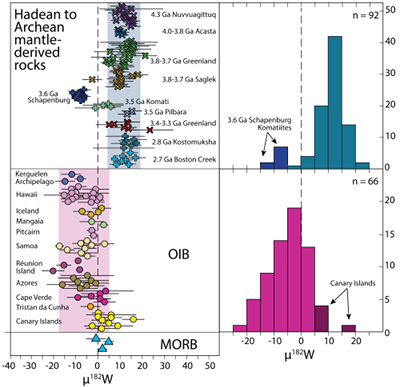 Figure 2 Compilation of all existing 182W/184W data shown as µ182W values. Hadean and Archean mantle-derived rocks are organised in order of their age, with the oldest at the top and the youngest at the bottom. Shaded areas show the average µ182W values ± 2 s.d. for Hadean-Archean and OIB samples. OIB: Ocean Island Basalts. MORB: Mid-Ocean Ridge Basalts. Data sources: Willbold et al., 2011, 2015; Touboul et al., 2012, 2014; Liu et al., 2016; Puchtel et al., 2016, 2018; Rizo et al., 2016a,b; Dale et al., 2017; Mundl et al., 2017; Kruijer and Kleine, 2018; Mei et al., 2018; Reimink et al., 2018; and this study. | 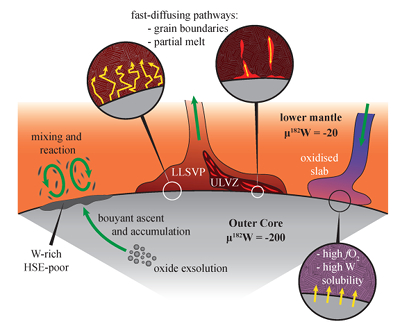 Figure 3 Schematic cartoon showing possible processes for core-mantle chemical interaction. |
| Table 1 | Figure 1 | Figure 2 | Figure 3 |
top
Letter
Deep-rooted upwelling mantle plumes are potential candidates for carrying geochemical evidence of chemical interaction between the liquid outer core and the base of the mantle. Ocean island basalts (OIB), erupted at hotspots, are the surface expression of these mantle plumes. While the He and Os isotope compositions and Fe/Mn ratios of these magmas have been interpreted as possible evidence for core-mantle exchange (e.g., Walker et al., 1995
Walker, R.J., Morgan, J.W., Horan, M.F. (1995) Osmium-187 enrichment in some plumes: evidence for core-mantle interaction?. Science 269, 819-822.
; Brandon et al., 1998Brandon, A.D., Walker, R.J., Morgan, J.W., Norman, M.D., Prichard, H.M. (1998) Coupled 186Os and 187Os evidence for core-mantle interaction. Science 280, 1570-1573.
; Porcelli and Halliday, 2001Porcelli, D., Halliday, A.N. (2001) The core as a possible source of mantle helium. Earth and Planetary Science Letters 192, 45-56.
; Humayun et al., 2004Humayun, M., Qin, L., Norman, M.D. (2004) Geochemical evidence for excess iron in the mantle beneath Hawaii. Science 306, 91-94.
; Bouhifd et al., 2013Bouhifd, M.A., Jephcoat, A.P., Heber, V.S., Kelley, S.P. (2013) Helium in an early Earth’s core. Nature Geoscience 6, 982-986.
), other interpretations have also been invoked (e.g., Sobolev et al., 2007Sobolev, A.V., Hofmann, A.W., Kuzmin, D.V., Yaxley, G.M., Arndt, N.T., Chung, S.L., Danyushevsky, L.V., Elliott, T., Frey, F.A., Garcia, M.O., Gurenko, A.A., Kamenetsky, V.S., Kerr, A.C., Krivolutskaya, N.A., Matvienkov, V.V., Nikogosian, I.K., Rocholl, A., Sigurdsson, I.A., Sushchevskaya, N.M., Teklay, M. (2007) The amount of recycled crust in sources of mantle-derived melts. Science 316, 412-417.
; Lassiter, 2006Lassiter, J.C. (2006) Constraints on the coupled thermal evolution of the Earth's core and mantle, the age of the inner core, and the origin of the 186Os/188Os “core signal” in plume-derived lavas. Earth and Planetary Science Letters 250, 306-317.
; Luguet et al., 2008Luguet, A., Pearson, D.G., Nowell, G.M., Dreher, S.T., Coggon, J.A., Spetsius, Z.V., Parman, S. W. (2008) Enriched Pt-Re-Os isotope systematics in plume lavas explained by metasomatic sulfides. Science 319, 453-456.
).Strong evidence for core-mantle interaction may come from the short-lived 182Hf-182W system. With a half-life of 8.9 Ma (Vockenhuber et al., 2004
Vockenhuber, C., Oberli, F., Bichler, M., Ahmad, I., Quitté, G., Meier, M., Halliday, A.N., Lee, D.-C., Kutschera, W., Steier, P., Gehrke, R.J., Helmer, R.G. (2004) New Half-Life Measurement of Hf-182: Improved Chronometer for the Early Solar System. Physical Review Letters 93, 172501.
), 182Hf decayed into 182W during the first ~50 Myr of the solar system’s history. Since Hf is a lithophile element, it is concentrated in the silicate portion of the Earth. In contrast, W partitions preferentially into metal, and mass balance calculations suggest that ~90 % of the Earth’s W resides in the core (McDonough, 2003McDonough, W.F. (2003) Compositional model for the Earth's core. Treatise on geochemistry 2, 568.
). The difference in the W isotopic composition of the Earth’s mantle and chondritic meteorites implies that the W-rich core has a 182W/184W ratio ~200 ppm lower than the mantle (e.g., Kleine et al., 2009Kleine, T., Touboul, M., Bourdon, B., Nimmo, F., Mezger, K., Palme, H., Jacobsen, S.B., Yin, Q.-Z., Halliday, A.N. (2009) Hf–W chronology of the accretion and early evolution of asteroids and terrestrial planets. Geochimica et Cosmochimica Acta 73, 5150-5188.
). Therefore, chemical exchange between the core and the source of mantle plumes could be detectable in the 182W/184W ratio of OIB.The samples studied here are plume-related volcanic rocks from the Réunion Island and the Kerguelen Archipelago hotspots, the certified reference material Hawaiian basalt BHVO-2, as well as samples from the ~3.475 Ga Mount Ada Basalts of the Pilbara Craton (samples and analytical methods are described in the Supplementary Information). The 182W isotope compositions of these samples are presented as µ182W values in Table 1 and Figure 1, which are deviations in ppm from the W isotopic composition of the terrestrial standard (assumed µ182W = 0). All plume-related samples analysed here yield negative µ182W values ranging from -5.2 ± 3.7 to -20.2 ± 5.1, including BHVO-2, which yields an average µ182W of -6.6 ± 1.9, consistent with previous reports (Willbold et al., 2011
Willbold, M., Elliott, T., Moorbath, S. (2011) The tungsten isotopic composition of the Earth’s mantle before the terminal bombardment. Nature 477, 195.
; Mundl et al., 2017Mundl, A., Touboul, M., Jackson, M.G., Day, J.M., Kurz, M.D., Lekic, V., Helz, R.T., Walker, R.J. (2017) Tungsten-182 heterogeneity in modern ocean island basalts. Science 356, 66-69.
; Kruijer and Kleine, 2018Kruijer, T.S., Kleine, T. (2018) No 182W excess in the Ontong Java Plateau source. Chemical Geology 485, 24-31.
; Mei et al., 2018Mei, Q.F., Yang, J.H., Yang, Y.H. (2018) An improved extraction chromatographic purification of tungsten from a silicate matrix for high precision isotopic measurements using MC-ICPMS. Journal of Analytical Atomic Spectrometry 33, 569-577.
). In contrast, the ~3.475 Ga Mt. Ada Basalts samples yield positive µ182W values of +15.3 ± 4.6 and +13.1 ± 4.1, in the same range as most Hadean and Eoarchean mantle-derived rocks. Deviations measured in µ182W are not associated with deviations in µ183W, confirming that 182W variability is not the result of nuclear field shift effects (Figs. S-1 and S-2).Table 1 Tungsten isotope results for rock samples from the Pilbara Craton, the Kerguelen Archipelago, Réunion Island and the Hawaiian basalt BHVO-2.
| Location | Sample | µ182W | µ183W |
| Réunion Island | REU 1001-053 | -19.0 ± 4.0 | -3.3 ± 3.5 |
| REU 1001-053 duplicate | -12.4 ± 5.0 | -1.6 ± 4.0 | |
| REU 1001-053 average | -15.7 ± 3.2 | -2.4 ± 2.7 | |
| REU 1406-24.9a | -20.2 ± 5.1 | -5.8 ± 4.7 | |
| REU 863-204 | -8.7 ± 3.8 | 0.7 ± 3.3 | |
| REU 863-204 duplicate | -9.2 ± 4.0 | -0.8 ± 3.4 | |
| REU 863-204 average | -8.9 ± 2.8 | -0.1 ± 2.4 | |
| REU 0609-131 | -7.6 ± 5.3 | 0.4 ± 4.7 | |
| REU 0609-131 duplicate | -8.8 ± 3.9 | 4.0 ± 3.2 | |
| REU 0609-131 average | -8.2 ± 3.3 | 2.2 ± 2.9 | |
| Kerguelen Plateau | TC0603 | -16.5 ± 8.5 | -3.1 ± 5.8 |
| TC0603 duplicate | -7.3 ± 4.0 | 2.1 ± 3.4 | |
| TC0603 average | -11.9 ± 4.7 | -0.5 ± 3.3 | |
| CT02-358 | -9.4 ± 7.4 | -2.8 ± 7.2 | |
| CT02-358 duplicate | -7.4 ± 3.0 | 1.9 ± 2.6 | |
| CT02-358 average | -8.4 ± 4.0 | -0.4 ± 3.8 | |
| CT02-548 | -15.2 ± 4.6 | 1.1 ± 3.7 | |
| Hawaii | BHVO-2 | -7.2 ± 4.5 | -0.9 ± 3.9 |
| BHVO-2 duplicate | -5.9 ± 4.5 | 4.3 ± 3.9 | |
| BHVO-2 average | -6.6 ± 3.2 | 1.7 ± 2.8 | |
| Pilbara Craton | AH-25 | 15.3 ± 4.6 | 2.4 ± 3.7 |
| AH-26 | 13.1 ± 4.1 | 5.2 ± 3.5 |
µXW values (µXW = ([(XW/184W)sample/(XW/184W)standard]-1) x 106) are relative deviations of the W isotope composition of the samples from the Alfa Aesar W terrestrial standard in ppm. The standard was measured repeatedly between samples and yields a reproducibility on the 182W/184W ratio of 4.7 ppm (2 s.d., n = 11). Duplicates are measurements from different rock digestions. Errors on individual measurements are 2 standard error (2 s.e.) and averages show the propagated uncertainties on the average of multiple duplicates.
Download in Excel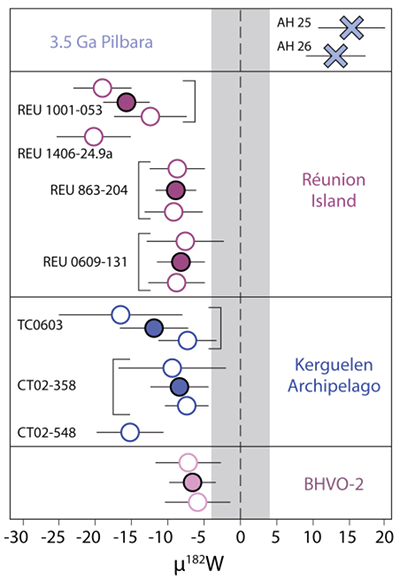
Figure 1 182W/184W data obtained in this study shown as µ182W values. Open symbols are individual analysis of samples and filled symbols show the average of the different duplicates. Errors on individual measurements shown are 2 standard error (2 s.e.) and propagated uncertainties are shown for averages. The shaded area represents the reproducibility obtained (2 s.d.) on repeated measurements of the Alfa Aesar W standard.
Coupled with other high precision W isotope studies of mantle-derived rocks, the data reveal that the 182W isotopic composition in the Hadean-Archaean mantle was different from the modern mantle (Fig. 2). With the exception of the ~3.55 Ga Schapenburg komatiites, Hadean to Archean volcanism sampled a mantle characterised by 182W excesses of +5 to +20 ppm. In contrast, the mantle accessed by modern mantle-plume magmatism is characterised by 182W anomalies from +5 to -20 ppm. The lavas from the Canary Islands are the only OIB to display resolvable 182W excesses, however, this hotspot seems to originate at shallower depths (King and Ritsema, 2000
King, S.D., Ritsema, J. (2000) African hot spot volcanism: small-scale convection in the upper mantle beneath cratons. Science 290, 1137-1140.
; Courtillot et al., 2003Courtillot, V., Davaille, A., Besse, J., Stock, J. (2003) Three distinct types of hotspots in the Earth’s mantle. Earth and Planetary Science Letters 205, 295-308.
) and various geochemical tracers suggest these magmas were contaminated by the ancient continental root (e.g., Thirlwall et al., 1997Thirlwall, M.F., Jenkins, C., Vroon, P.Z., Mattey, D.P. (1997) Crustal interaction during construction of ocean islands: Pb-Sr-Nd-O isotope geochemistry of the shield basalts of Gran Canaria, Canary Islands. Chemical Geology 135, 233-262.
).
Figure 2 Compilation of all existing 182W/184W data shown as µ182W values. Hadean and Archean mantle-derived rocks are organised in order of their age, with the oldest at the top and the youngest at the bottom. Shaded areas show the average µ182W values ± 2 s.d. for Hadean-Archean and OIB samples. OIB: Ocean Island Basalts. MORB: Mid-Ocean Ridge Basalts. Data sources: Willbold et al., 2011
Willbold, M., Elliott, T., Moorbath, S. (2011) The tungsten isotopic composition of the Earth’s mantle before the terminal bombardment. Nature 477, 195.
, 2015Willbold, M., Mojzsis, S.J., Chen, H.W., Elliott, T. (2015) Tungsten isotope composition of the Acasta Gneiss Complex. Earth and Planetary Science Letters 419, 168-177.
; Touboul et al., 2012Touboul, M., Puchtel, I.S., Walker, R.J. (2012) 182W evidence for long-term preservation of early mantle differentiation products. Science 335, 1065-1069.
, 2014Touboul, M., Liu, J., O'Neil, J., Puchtel, I.S., Walker, R.J. (2014) New insights into the Hadean mantle revealed by 182W and highly siderophile element abundances of supracrustal rocks from the Nuvvuagittuq Greenstone Belt, Quebec, Canada. Chemical Geology 383, 63-75.
; Liu et al., 2016Liu, J., Touboul, M., Ishikawa, A., Walker, R.J., Pearson, D.G. (2016) Widespread tungsten isotope anomalies and W mobility in crustal and mantle rocks of the Eoarchean Saglek Block, northern Labrador, Canada: Implications for early Earth processes and W recycling. Earth and Planetary Science Letters 448, 13-23.
; Puchtel et al., 2016Puchtel, I.S., Blichert‐Toft, J., Touboul, M., Horan, M.F., Walker, R.J. (2016) The coupled 182W-142Nd record of early terrestrial mantle differentiation. Geochemistry, Geophysics, Geosystems 17, 2168-2193.
, 2018Puchtel, I.S., Blichert-Toft, J., Touboul, M., Walker, R.J. (2018) 182W and HSE constraints from 2.7 Ga komatiites on the heterogeneous nature of the Archean mantle. Geochimica et Cosmochimica Acta 228, 1-26.
; Rizo et al., 2016aRizo, H., Walker, R.J., Carlson, R.W., Horan, M.F., Mukhopadhyay, S., Manthos, V., Francis, D., Jackson, M.G. (2016a) Preservation of Earth-forming events in the tungsten isotopic composition of modern flood basalts. Science 352, 809-812.
,bRizo, H., Walker, R.J., Carlson, R.W., Touboul, M., Horan, M.F., Puchtel, I.S., Boyet, M., Rosing, M.T. (2016b) Early Earth differentiation investigated through 142Nd, 182W, and highly siderophile element abundances in samples from Isua, Greenland. Geochimica et Cosmochimica Acta 175, 319-336.
; Dale et al., 2017Dale, C.W., Kruijer, T.S., Burton, K.W. (2017) Highly siderophile element and 182W evidence for a partial late veneer in the source of 3.8 Ga rocks from Isua, Greenland. Earth and Planetary Science Letters 458, 394-404.
; Mundl et al., 2017Mundl, A., Touboul, M., Jackson, M.G., Day, J.M., Kurz, M.D., Lekic, V., Helz, R.T., Walker, R.J. (2017) Tungsten-182 heterogeneity in modern ocean island basalts. Science 356, 66-69.
; Kruijer and Kleine, 2018Kruijer, T.S., Kleine, T. (2018) No 182W excess in the Ontong Java Plateau source. Chemical Geology 485, 24-31.
; Mei et al., 2018Mei, Q.F., Yang, J.H., Yang, Y.H. (2018) An improved extraction chromatographic purification of tungsten from a silicate matrix for high precision isotopic measurements using MC-ICPMS. Journal of Analytical Atomic Spectrometry 33, 569-577.
; Reimink et al., 2018Reimink, J.R., Chacko, T., Carlson, R.W., Shirey, S.B., Liu, J., Stern, R.A., Bauer, A.M., Pearson, D.G., Heaman, L.M. (2018) Petrogenesis and tectonics of the Acasta Gneiss Complex derived from integrated petrology and 142Nd and 182W extinct nuclide-geochemistry. Earth and Planetary Science Letters 494, 12-22.
; and this study.Several processes have been proposed to explain the cause of 182W variability. None of these processes, however, seems to explain all geochemical observations satisfactorily. For example, excesses in 182W observed in ancient rock samples could arise if they derived from mantle sources that remained partially isolated from the incorporation, after core formation, of meteoritic material (e.g., Willbold et al., 2011
Willbold, M., Elliott, T., Moorbath, S. (2011) The tungsten isotopic composition of the Earth’s mantle before the terminal bombardment. Nature 477, 195.
). This late-accreted material is assumed to possess µ182W ~ -200, and its gradual homogenisation into the mantle would have decreased its µ182W with time. Late accretion of ~0.5 wt. % of the Earth has also been invoked to explain the higher than expected highly siderophile element (HSE; Re, Os, Ir, Ru, Pt, Pd) abundances in Earth’s mantle (e.g., Chou et al., 1978Chou, C.L. (1978) Fractionation of siderophile elements in the Earth's upper mantle. Proceedings of the 9th Lunar and Planetary Science Conference 1, 219-230.
; Walker, 2009Walker, R.J. (2009) Highly siderophile elements in the Earth, Moon and Mars: update and implications for planetary accretion and differentiation. Chemie der Erde-Geochemistry 69, 101-125.
). Therefore, variability of 182W is expected to correlate with HSE source abundances. Yet, it rarely does, and the HSE depleted Schapenburg samples even indicate the opposite relationship (Puchtel et al., 2016Puchtel, I.S., Blichert‐Toft, J., Touboul, M., Horan, M.F., Walker, R.J. (2016) The coupled 182W-142Nd record of early terrestrial mantle differentiation. Geochemistry, Geophysics, Geosystems 17, 2168-2193.
). Estimating HSE abundances of mantle sources is, however, complicated since these elements are controlled by sulphides, whose partial melting behaviour is very complex.Another proposed process is that early (<50 Ma) silicate differentiation, following crystallisation of a magma ocean, could have also created 182W variability. Since W is more incompatible than Hf (Shearer and Righter, 2003
Shearer, C.K., Righter, K. (2003) Behavior of tungsten and hafnium in silicates: a crystal chemical basis for understanding the early evolution of the terrestrial planets. Geophysical Research Letters 30, 7-1.
), early differentiated reservoirs will be characterised by fractionated Hf/W ratios and develop excesses and deficits in 182W. Silicate differentiation in the first 50 Ma of Earth’s history should have also affected the short-lived 146Sm-142Nd isotope system (t1/2 = 103 Ma; Marks et al., 2014Marks, N.E., Borg, L.E., Hutcheon, I.D., Jacobsen, B., Clayton, R.N. (2014) Samarium–neodymium chronology and rubidium–strontium systematics of an Allende calcium–aluminum-rich inclusion with implications for 146Sm half-life. Earth and Planetary Science Letters 405, 15-24.
). Coupled 142Nd and 182W anomalies in the ancient rock record, however, are not ubiquitous and most modern mantle rocks measured so far exhibit 142Nd variations that deviate by less than 5 ppm from the terrestrial standard (Fig. S-3).While the scenarios discussed above might explain some of the 182W anomalies detected in the rock record, the temporal shift observed in the W isotopic composition of the mantle seems to reflect one predominating process. Chemical interaction between the core and the mantle sources of plumes could be such a process. Core-mantle interaction does not affect lithophile elements such as Nd, and is thus compatible with the observed lack of coupling between 182W and 142Nd. Furthermore, the correlations between 182W and 3He/4He ratios (Mundl et al., 2017
Mundl, A., Touboul, M., Jackson, M.G., Day, J.M., Kurz, M.D., Lekic, V., Helz, R.T., Walker, R.J. (2017) Tungsten-182 heterogeneity in modern ocean island basalts. Science 356, 66-69.
) and Fe/Mn ratios (Fig. S-4) could corroborate this process, since both He and Fe/Mn have also been proposed as tracers of core-mantle interaction (Porcelli and Halliday, 2001Porcelli, D., Halliday, A.N. (2001) The core as a possible source of mantle helium. Earth and Planetary Science Letters 192, 45-56.
; Humayun et al., 2004Humayun, M., Qin, L., Norman, M.D. (2004) Geochemical evidence for excess iron in the mantle beneath Hawaii. Science 306, 91-94.
; Bouhifd et al., 2013Bouhifd, M.A., Jephcoat, A.P., Heber, V.S., Kelley, S.P. (2013) Helium in an early Earth’s core. Nature Geoscience 6, 982-986.
). In this scenario, the Earth’s mantle, initially characterised by a maximum µ182W value of +20, was subject to core addition that created domains with µ182W values as low as -20. The most negative µ182W values measured in OIB constrain the maximum core contribution to their sources to ~0.8 wt. %, calculated by mass balance assuming a core µ182W value of -200 (Kleine et al., 2009Kleine, T., Touboul, M., Bourdon, B., Nimmo, F., Mezger, K., Palme, H., Jacobsen, S.B., Yin, Q.-Z., Halliday, A.N. (2009) Hf–W chronology of the accretion and early evolution of asteroids and terrestrial planets. Geochimica et Cosmochimica Acta 73, 5150-5188.
) and W concentration of ~500 ppb (McDonough, 2003McDonough, W.F. (2003) Compositional model for the Earth's core. Treatise on geochemistry 2, 568.
).Diffusive isotope exchange of W at the core-mantle boundary (CMB) is one of the plausible mechanisms of core-mantle interaction (Fig. 3). At CMB conditions, grain boundary diffusion experiments indicate W can diffuse over distances of 1-10 km in the mantle over 100 Myr (Hayden and Watson, 2007
Hayden, L.A., Watson, E.B. (2007) A diffusion mechanism for core–mantle interaction. Nature 450, 709.
) and even higher diffusion rates may arise from the presence of partially molten silicates at the CMB (e.g., Andrault et al., 2014Andrault, D., Pesce, G., Bouhifd, M.A., Bolfan-Casanova, N., Hénot, J.M., Mezouar, M. (2014) Melting of subducted basalt at the core-mantle boundary. Science 344, 892-895.
; Yuan and Romanowicz, 2017Yuan, K., Romanowicz, B. (2017) Seismic evidence for partial melting at the root of major hot spot plumes. Science 357, 393-397.
). Hayden and Watson (2007)Hayden, L.A., Watson, E.B. (2007) A diffusion mechanism for core–mantle interaction. Nature 450, 709.
also determined the grain boundary diffusivity of the HSE, and concluded that these elements are also susceptible to ‘leaking’ from the core over geological timescales. The high concentrations of HSE in the core relative to the mantle mean that even a small flux of HSEs from the core should result in coupling between µ182W and HSE abundances in mantle-derived rocks. As discussed above, mantle-derived rocks with negative µ182W values do not possess HSE enrichments, perhaps suggesting that this is not the primary mechanism of core-mantle interaction. However, relating HSE concentrations in mantle-derived rocks to the composition of their source regions is challenging and means we cannot rule out diffusion as a viable mechanism.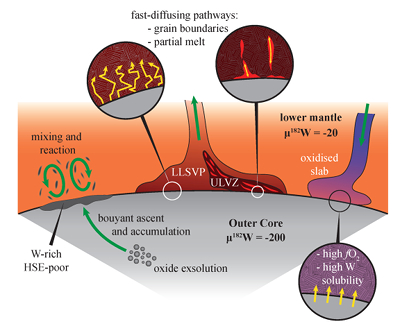
Figure 3 Schematic cartoon showing possible processes for core-mantle chemical interaction.
Core-mantle interaction could be also a consequence of Si-Mg-Fe oxide exsolutions from the core (Badro et al., 2016
Badro, J., Siebert, J., Nimmo, F. (2016) An early geodynamo driven by exsolution of mantle components from Earth’s core. Nature 536, 326.
; O’Rourke and Stevenson, 2016O’Rourke, J.G., Stevenson, D.J. (2016) Powering Earth’s dynamo with magnesium precipitation from the core. Nature 529, 387.
; Hirose et al., 2017Hirose, K., Morard, G., Sinmyo, R., Umemoto, K., Hernlund, J., Helffrich, G., Labrosse, S. (2017) Crystallization of silicon dioxide and compositional evolution of the Earth’s core. Nature 543, 99.
) (Fig. 3). Our experimental results show that these oxides can efficiently incorporate W in their structure without the accompanying HSE (Supplementary Information; Figs. S-5 and S-6). These exsolutions are expected to form by simple secular core cooling, since the solubility of oxides in liquid iron decreases with decreasing temperature (Badro et al., 2016Badro, J., Siebert, J., Nimmo, F. (2016) An early geodynamo driven by exsolution of mantle components from Earth’s core. Nature 536, 326.
; O’Rourke and Stevenson, 2016O’Rourke, J.G., Stevenson, D.J. (2016) Powering Earth’s dynamo with magnesium precipitation from the core. Nature 529, 387.
; Hirose et al., 2017Hirose, K., Morard, G., Sinmyo, R., Umemoto, K., Hernlund, J., Helffrich, G., Labrosse, S. (2017) Crystallization of silicon dioxide and compositional evolution of the Earth’s core. Nature 543, 99.
). Additional to core cooling, the crystallisation of the inner core likely led to higher oxygen concentrations in the outer liquid core and increased Si-Mg-Fe oxide precipitation, since oxygen is not easily incorporated into solid iron (Alfè et al., 2002Alfè, D., Price, G.D., Gillan, M.J. (2002) Iron under Earth’s core conditions: Liquid-state thermodynamics and high-pressure melting curve from ab initio calculations. Physical Review B 65, 16511.
). More oxidising conditions in the outer core decreases the affinity of W for the liquid metal (Righter and Ghiorso, 2012Righter, K., Ghiorso, M.S. (2012) Redox systematics of a magma ocean with variable pressure-temperature gradients and composition. Proceedings of the National Academy of Sciences 109, 11955-11960.
; Wade et al., 2012Wade, J., Wood, B.J., Tuff, J. (2012) Metal–silicate partitioning of Mo and W at high pressures and temperatures: evidence for late accretion of sulphur to the Earth. Geochimica et Cosmochimica Acta 85, 58-74.
), inducing the extraction of W from the core and its incorporation into the mantle.Regardless of the exact mechanism of core-mantle interaction, a key observation to consider is that the mantle between 4.3 Ga and 2.7 Ga seems to be characterised by constant µ182W values, which have decreased in the modern mantle (Fig. 2). This broad distinction in µ182W vs. age could imply a change in mantle dynamics after the Archean. Slab subduction of oxidised material into the deep mantle might have induced W disequilibrium at the CMB by increasing its fO2 (van der Hilst and Kárason, 1999
van der Hilst, R.D., Kárason, H. (1999) Compositional heterogeneity in the bottom 1000 kilometers of Earth's mantle: toward a hybrid convection model. Science 283, 1885-1888.
). Since W adopts a high valence (4+ to 6+) in silicates, increasing the fO2 at the CMB decreases its siderophile behaviour (e.g., Righter and Ghiorso, 2012Righter, K., Ghiorso, M.S. (2012) Redox systematics of a magma ocean with variable pressure-temperature gradients and composition. Proceedings of the National Academy of Sciences 109, 11955-11960.
; Wade et al., 2012Wade, J., Wood, B.J., Tuff, J. (2012) Metal–silicate partitioning of Mo and W at high pressures and temperatures: evidence for late accretion of sulphur to the Earth. Geochimica et Cosmochimica Acta 85, 58-74.
), favouring its extraction from the core and incorporation in the lower mantle. Deep slab subduction might have also played a role in scavenging material from the CMB. Alternatively, the change of µ182W values in the post-Archaean mantle could be related to the crystallisation of the inner core. Large experimental uncertainties on thermal conductivity values of liquid iron in the outer core limit our understanding of inner core crystallisation. If changes in the µ182W signature of deep mantle plumes are related to the onset of inner core segregation, µ182W could be used as an alternative tool to study this process.top
Acknowledgements
This manuscript was improved after insightful comments from G. Pearson and four anonymous reviewers and the editor, A. Luguet. We appreciate helpful discussions with R.W. Carlson, R. Walker and J. O’Neil, and discussions related to analytical protocols with G. Quitté, G. Archer and J. Blenkinsop. We thank L. Bouvier for her participation in the beginning of this project, and S. Zhang for assistance with TIMS, and N. DeSilva and S. Mohanty for assistance with ICP-MS facilities. We also thank the Geological Survey of Western Australia and R. Hepple for assistance with collection of the Pilbara Craton samples. This research was supported by a Natural Sciences and Engineering Research Council of Canada (NSERC) Discovery grant to H. Rizo (RGPIN-2015-03982), and by the Fonds de Recherche Nature et Technologies (FRQNT) start up programme for new university researchers.
Editor: Ambre Luguet
top
References
Alfè, D., Price, G.D., Gillan, M.J. (2002) Iron under Earth’s core conditions: Liquid-state thermodynamics and high-pressure melting curve from ab initio calculations. Physical Review B 65, 16511.
 Show in context
Show in contextAdditional to core cooling, the crystallisation of the inner core likely led to higher oxygen concentrations in the outer liquid core and increased Si-Mg-Fe oxide precipitation, since oxygen is not easily incorporated into solid iron (Alfè et al., 2002).
View in article
Andrault, D., Pesce, G., Bouhifd, M.A., Bolfan-Casanova, N., Hénot, J.M., Mezouar, M. (2014) Melting of subducted basalt at the core-mantle boundary. Science 344, 892-895.
 Show in context
Show in context At CMB conditions, grain boundary diffusion experiments indicate W can diffuse over distances of 1-10 km in the mantle over 100 Myr (Hayden and Watson, 2007) and even higher diffusion rates may arise from the presence of partially molten silicates at the CMB (e.g., Andrault et al., 2014; Yuan and Romanowicz, 2017).
View in article
Badro, J., Siebert, J., Nimmo, F. (2016) An early geodynamo driven by exsolution of mantle components from Earth’s core. Nature 536, 326.
 Show in context
Show in context Core-mantle interaction could be also a consequence of Si-Mg-Fe oxide exsolutions from the core (Badro et al., 2016; O’Rourke and Stevenson, 2016; Hirose et al., 2017) (Fig. 3).
View in article
These exsolutions are expected to form by simple secular core cooling, since the solubility of oxides in liquid iron decreases with decreasing temperature (Badro et al., 2016; O’Rourke and Stevenson, 2016; Hirose et al., 2017).
View in article
Brandon, A.D., Walker, R.J., Morgan, J.W., Norman, M.D., Prichard, H.M. (1998) Coupled 186Os and 187Os evidence for core-mantle interaction. Science 280, 1570-1573.
 Show in context
Show in contextWhile the He and Os isotope compositions and Fe/Mn ratios of these magmas have been interpreted as possible evidence for core-mantle exchange (e.g., Walker et al., 1995; Brandon et al., 1998; Porcelli and Halliday, 2001; Humayun et al., 2004; Bouhifd et al., 2013), other interpretations have also been invoked (e.g., Sobolev et al., 2007; Lassiter, 2006; Luguet et al., 2008).
View in article
Bouhifd, M.A., Jephcoat, A.P., Heber, V.S., Kelley, S.P. (2013) Helium in an early Earth’s core. Nature Geoscience 6, 982-986.
 Show in context
Show in context While the He and Os isotope compositions and Fe/Mn ratios of these magmas have been interpreted as possible evidence for core-mantle exchange (e.g., Walker et al., 1995; Brandon et al., 1998; Porcelli and Halliday, 2001; Humayun et al., 2004; Bouhifd et al., 2013), other interpretations have also been invoked (e.g., Sobolev et al., 2007; Lassiter, 2006; Luguet et al., 2008).
View in article
Furthermore, the correlations between 182W and 3He/4He ratios (Mundl et al., 2017) and Fe/Mn ratios (Fig. S-4) could corroborate this process, since both He and Fe/Mn have also been proposed as tracers of core-mantle interaction (Porcelli and Halliday, 2001; Humayun et al., 2004; Bouhifd et al., 2013).
View in article
Chou, C.L. (1978) Fractionation of siderophile elements in the Earth's upper mantle. Proceedings of the 9th Lunar and Planetary Science Conference 1, 219-230.
 Show in context
Show in context Late accretion of ~0.5 wt. % of the Earth has also been invoked to explain the higher than expected highly siderophile element (HSE; Re, Os, Ir, Ru, Pt, Pd) abundances in Earth’s mantle (e.g., Chou et al., 1978; Walker, 2009).
View in article
Courtillot, V., Davaille, A., Besse, J., Stock, J. (2003) Three distinct types of hotspots in the Earth’s mantle. Earth and Planetary Science Letters 205, 295-308.
 Show in context
Show in context The lavas from the Canary Islands are the only OIB to display resolvable 182W excesses, however, this hotspot seems to originate at shallower depths (King and Ritsema, 2000; Courtillot et al., 2003) and various geochemical tracers suggest these magmas were contaminated by the ancient continental root (e.g., Thirlwall et al., 1997).
View in article
Dale, C.W., Kruijer, T.S., Burton, K.W. (2017) Highly siderophile element and 182W evidence for a partial late veneer in the source of 3.8 Ga rocks from Isua, Greenland. Earth and Planetary Science Letters 458, 394-404.
 Show in context
Show in context Figure 2 [...] Data sources: Willbold et al., 2011, 2015; Touboul et al., 2012, 2014; Liu et al., 2016; Puchtel et al., 2016, 2018; Rizo et al., 2016a,b; Dale et al., 2017; Mundl et al., 2017; Kruijer and Kleine, 2018; Mei et al., 2018; Reimink et al., 2018; and this study.
View in article
Hayden, L.A., Watson, E.B. (2007) A diffusion mechanism for core–mantle interaction. Nature 450, 709.
 Show in context
Show in contextAt CMB conditions, grain boundary diffusion experiments indicate W can diffuse over distances of 1-10 km in the mantle over 100 Myr (Hayden and Watson, 2007) and even higher diffusion rates may arise from the presence of partially molten silicates at the CMB (e.g., Andrault et al., 2014; Yuan and Romanowicz, 2017).
View in article
Hayden and Watson (2007) also determined the grain boundary diffusivity of the HSE, and concluded that these elements are also susceptible to ‘leaking’ from the core over geological timescales.
View in article
Hirose, K., Morard, G., Sinmyo, R., Umemoto, K., Hernlund, J., Helffrich, G., Labrosse, S. (2017) Crystallization of silicon dioxide and compositional evolution of the Earth’s core. Nature 543, 99.
 Show in context
Show in context Core-mantle interaction could be also a consequence of Si-Mg-Fe oxide exsolutions from the core (Badro et al., 2016; O’Rourke and Stevenson, 2016; Hirose et al., 2017) (Fig. 3).
View in article
These exsolutions are expected to form by simple secular core cooling, since the solubility of oxides in liquid iron decreases with decreasing temperature (Badro et al., 2016; O’Rourke and Stevenson, 2016; Hirose et al., 2017).
View in article
Humayun, M., Qin, L., Norman, M.D. (2004) Geochemical evidence for excess iron in the mantle beneath Hawaii. Science 306, 91-94.
 Show in context
Show in contextWhile the He and Os isotope compositions and Fe/Mn ratios of these magmas have been interpreted as possible evidence for core-mantle exchange (e.g., Walker et al., 1995; Brandon et al., 1998; Porcelli and Halliday, 2001; Humayun et al., 2004; Bouhifd et al., 2013), other interpretations have also been invoked (e.g., Sobolev et al., 2007; Lassiter, 2006; Luguet et al., 2008).
View in article
Furthermore, the correlations between 182W and 3He/4He ratios (Mundl et al., 2017) and Fe/Mn ratios (Fig. S-4) could corroborate this process, since both He and Fe/Mn have also been proposed as tracers of core-mantle interaction (Porcelli and Halliday, 2001; Humayun et al., 2004; Bouhifd et al., 2013).
View in article
Kleine, T., Touboul, M., Bourdon, B., Nimmo, F., Mezger, K., Palme, H., Jacobsen, S.B., Yin, Q.-Z., Halliday, A.N. (2009) Hf–W chronology of the accretion and early evolution of asteroids and terrestrial planets. Geochimica et Cosmochimica Acta 73, 5150-5188.
 Show in context
Show in context The difference in the W isotopic composition of the Earth’s mantle and chondritic meteorites implies that the W-rich core has a 182W/184W ratio ~200 ppm lower than the mantle (e.g., Kleine et al., 2009).
View in article
The most negative µ182W values measured in OIB constrain the maximum core contribution to their sources to ~0.8 wt. %, calculated by mass balance assuming a core µ182W value of -200 (Kleine et al., 2009) and W concentration of ~500 ppb (McDonough, 2003).
View in article
King, S.D., Ritsema, J. (2000) African hot spot volcanism: small-scale convection in the upper mantle beneath cratons. Science 290, 1137-1140.
 Show in context
Show in context The lavas from the Canary Islands are the only OIB to display resolvable 182W excesses, however, this hotspot seems to originate at shallower depths (King and Ritsema, 2000; Courtillot et al., 2003) and various geochemical tracers suggest these magmas were contaminated by the ancient continental root (e.g., Thirlwall et al., 1997).
View in article
Kruijer, T.S., Kleine, T. (2018) No 182W excess in the Ontong Java Plateau source. Chemical Geology 485, 24-31.
 Show in context
Show in context All plume-related samples analysed here yield negative µ182W values ranging from -5.2 ± 3.7 to -20.2 ± 5.1, including BHVO-2, which yields an average µ182W of -6.6 ± 1.9, consistent with previous reports (Willbold et al., 2011; Mundl et al., 2017; Kruijer and Kleine, 2018; Mei et al., 2018).
View in article
Figure 2 [...] Data sources: Willbold et al., 2011, 2015; Touboul et al., 2012, 2014; Liu et al., 2016; Puchtel et al., 2016, 2018; Rizo et al., 2016a,b; Dale et al., 2017; Mundl et al., 2017; Kruijer and Kleine, 2018; Mei et al., 2018; Reimink et al., 2018; and this study.
View in article
Lassiter, J.C. (2006) Constraints on the coupled thermal evolution of the Earth's core and mantle, the age of the inner core, and the origin of the 186Os/188Os “core signal” in plume-derived lavas. Earth and Planetary Science Letters 250, 306-317.
 Show in context
Show in context While the He and Os isotope compositions and Fe/Mn ratios of these magmas have been interpreted as possible evidence for core-mantle exchange (e.g., Walker et al., 1995; Brandon et al., 1998; Porcelli and Halliday, 2001; Humayun et al., 2004; Bouhifd et al., 2013), other interpretations have also been invoked (e.g., Sobolev et al., 2007; Lassiter, 2006; Luguet et al., 2008).
View in article
Liu, J., Touboul, M., Ishikawa, A., Walker, R.J., Pearson, D.G. (2016) Widespread tungsten isotope anomalies and W mobility in crustal and mantle rocks of the Eoarchean Saglek Block, northern Labrador, Canada: Implications for early Earth processes and W recycling. Earth and Planetary Science Letters 448, 13-23.
 Show in context
Show in context Figure 2 [...] Data sources: Willbold et al., 2011, 2015; Touboul et al., 2012, 2014; Liu et al., 2016; Puchtel et al., 2016, 2018; Rizo et al., 2016a,b; Dale et al., 2017; Mundl et al., 2017; Kruijer and Kleine, 2018; Mei et al., 2018; Reimink et al., 2018; and this study.
View in article
Luguet, A., Pearson, D.G., Nowell, G.M., Dreher, S.T., Coggon, J.A., Spetsius, Z.V., Parman, S. W. (2008) Enriched Pt-Re-Os isotope systematics in plume lavas explained by metasomatic sulfides. Science 319, 453-456.
 Show in context
Show in context While the He and Os isotope compositions and Fe/Mn ratios of these magmas have been interpreted as possible evidence for core-mantle exchange (e.g., Walker et al., 1995; Brandon et al., 1998; Porcelli and Halliday, 2001; Humayun et al., 2004; Bouhifd et al., 2013), other interpretations have also been invoked (e.g., Sobolev et al., 2007; Lassiter, 2006; Luguet et al., 2008).
View in article
Marks, N.E., Borg, L.E., Hutcheon, I.D., Jacobsen, B., Clayton, R.N. (2014) Samarium–neodymium chronology and rubidium–strontium systematics of an Allende calcium–aluminum-rich inclusion with implications for 146Sm half-life. Earth and Planetary Science Letters 405, 15-24.
 Show in context
Show in context Silicate differentiation in the first 50 Ma of Earth’s history should have also affected the short-lived 146Sm-142Nd isotope system (t1/2 = 103 Ma; Marks et al., 2014).
View in article
McDonough, W.F. (2003) Compositional model for the Earth's core. Treatise on geochemistry 2, 568.
 Show in context
Show in contextIn contrast, W partitions preferentially into metal, and mass balance calculations suggest that ~90 % of the Earth’s W resides in the core (McDonough, 2003).
View in article
The most negative µ182W values measured in OIB constrain the maximum core contribution to their sources to ~0.8 wt. %, calculated by mass balance assuming a core µ182W value of -200 (Kleine et al., 2009) and W concentration of ~500 ppb (McDonough, 2003).
View in article
Mei, Q.F., Yang, J.H., Yang, Y.H. (2018) An improved extraction chromatographic purification of tungsten from a silicate matrix for high precision isotopic measurements using MC-ICPMS. Journal of Analytical Atomic Spectrometry 33, 569-577.
 Show in context
Show in context All plume-related samples analysed here yield negative µ182W values ranging from -5.2 ± 3.7 to -20.2 ± 5.1, including BHVO-2, which yields an average µ182W of -6.6 ± 1.9, consistent with previous reports (Willbold et al., 2011; Mundl et al., 2017; Kruijer and Kleine, 2018; Mei et al., 2018).
View in article
Figure 2 [...] Data sources: Willbold et al., 2011, 2015; Touboul et al., 2012, 2014; Liu et al., 2016; Puchtel et al., 2016, 2018; Rizo et al., 2016a,b; Dale et al., 2017; Mundl et al., 2017; Kruijer and Kleine, 2018; Mei et al., 2018; Reimink et al., 2018; and this study.
View in article
Mundl, A., Touboul, M., Jackson, M.G., Day, J.M., Kurz, M.D., Lekic, V., Helz, R.T., Walker, R.J. (2017) Tungsten-182 heterogeneity in modern ocean island basalts. Science 356, 66-69.
 Show in context
Show in contextAll plume-related samples analysed here yield negative µ182W values ranging from -5.2 ± 3.7 to -20.2 ± 5.1, including BHVO-2, which yields an average µ182W of -6.6 ± 1.9, consistent with previous reports (Willbold et al., 2011; Mundl et al., 2017; Kruijer and Kleine, 2018; Mei et al., 2018).
View in article
Figure 2 [...] Data sources: Willbold et al., 2011, 2015; Touboul et al., 2012, 2014; Liu et al., 2016; Puchtel et al., 2016, 2018; Rizo et al., 2016a,b; Dale et al., 2017; Mundl et al., 2017; Kruijer and Kleine, 2018; Mei et al., 2018; Reimink et al., 2018; and this study.
View in article
Furthermore, the correlations between 182W and 3He/4He ratios (Mundl et al., 2017) and Fe/Mn ratios (Fig. S-4) could corroborate this process, since both He and Fe/Mn have also been proposed as tracers of core-mantle interaction (Porcelli and Halliday, 2001; Humayun et al., 2004; Bouhifd et al., 2013).
View in article
O’Rourke, J.G., Stevenson, D.J. (2016) Powering Earth’s dynamo with magnesium precipitation from the core. Nature 529, 387.
 Show in context
Show in context Core-mantle interaction could be also a consequence of Si-Mg-Fe oxide exsolutions from the core (Badro et al., 2016; O’Rourke and Stevenson, 2016; Hirose et al., 2017) (Fig. 3).
View in article
These exsolutions are expected to form by simple secular core cooling, since the solubility of oxides in liquid iron decreases with decreasing temperature (Badro et al., 2016; O’Rourke and Stevenson, 2016; Hirose et al., 2017).
View in article
Porcelli, D., Halliday, A.N. (2001) The core as a possible source of mantle helium. Earth and Planetary Science Letters 192, 45-56.
 Show in context
Show in context While the He and Os isotope compositions and Fe/Mn ratios of these magmas have been interpreted as possible evidence for core-mantle exchange (e.g., Walker et al., 1995; Brandon et al., 1998; Porcelli and Halliday, 2001; Humayun et al., 2004; Bouhifd et al., 2013), other interpretations have also been invoked (e.g., Sobolev et al., 2007; Lassiter, 2006; Luguet et al., 2008).
View in article
Furthermore, the correlations between 182W and 3He/4He ratios (Mundl et al., 2017) and Fe/Mn ratios (Fig. S-4) could corroborate this process, since both He and Fe/Mn have also been proposed as tracers of core-mantle interaction (Porcelli and Halliday, 2001; Humayun et al., 2004; Bouhifd et al., 2013).
View in article
Puchtel, I.S., Blichert‐Toft, J., Touboul, M., Horan, M.F., Walker, R.J. (2016) The coupled 182W-142Nd record of early terrestrial mantle differentiation. Geochemistry, Geophysics, Geosystems 17, 2168-2193.
 Show in context
Show in contextFigure 2 [...] Data sources: Willbold et al., 2011, 2015; Touboul et al., 2012, 2014; Liu et al., 2016; Puchtel et al., 2016, 2018; Rizo et al., 2016a,b; Dale et al., 2017; Mundl et al., 2017; Kruijer and Kleine, 2018; Mei et al., 2018; Reimink et al., 2018; and this study.
View in article
Yet, it rarely does, and the HSE depleted Schapenburg samples even indicate the opposite relationship (Puchtel et al., 2016).
View in article
Puchtel, I.S., Blichert-Toft, J., Touboul, M., Walker, R.J. (2018) 182W and HSE constraints from 2.7 Ga komatiites on the heterogeneous nature of the Archean mantle. Geochimica et Cosmochimica Acta 228, 1-26.
 Show in context
Show in context Figure 2 [...] Data sources: Willbold et al., 2011, 2015; Touboul et al., 2012, 2014; Liu et al., 2016; Puchtel et al., 2016, 2018; Rizo et al., 2016a,b; Dale et al., 2017; Mundl et al., 2017; Kruijer and Kleine, 2018; Mei et al., 2018; Reimink et al., 2018; and this study.
View in article
Reimink, J.R., Chacko, T., Carlson, R.W., Shirey, S.B., Liu, J., Stern, R.A., Bauer, A.M., Pearson, D.G., Heaman, L.M. (2018) Petrogenesis and tectonics of the Acasta Gneiss Complex derived from integrated petrology and 142Nd and 182W extinct nuclide-geochemistry. Earth and Planetary Science Letters 494, 12-22.
 Show in context
Show in contextFigure 2 [...] Data sources: Willbold et al., 2011, 2015; Touboul et al., 2012, 2014; Liu et al., 2016; Puchtel et al., 2016, 2018; Rizo et al., 2016a,b; Dale et al., 2017; Mundl et al., 2017; Kruijer and Kleine, 2018; Mei et al., 2018; Reimink et al., 2018; and this study.
View in article
Righter, K., Ghiorso, M.S. (2012) Redox systematics of a magma ocean with variable pressure-temperature gradients and composition. Proceedings of the National Academy of Sciences 109, 11955-11960.
 Show in context
Show in context More oxidising conditions in the outer core decreases the affinity of W for the liquid metal (Righter and Ghiorso, 2012; Wade et al., 2012), inducing the extraction of W from the core and its incorporation into the mantle.
View in article
Since W adopts a high valence (4+ to 6+) in silicates, increasing the fO2 at the CMB decreases its siderophile behaviour (e.g., Righter and Ghiorso, 2012; Wade et al., 2012), favouring its extraction from the core and incorporation in the lower mantle.
View in article
Rizo, H., Walker, R.J., Carlson, R.W., Horan, M.F., Mukhopadhyay, S., Manthos, V., Francis, D., Jackson, M.G. (2016a) Preservation of Earth-forming events in the tungsten isotopic composition of modern flood basalts. Science 352, 809-812.
 Show in context
Show in context Figure 2 [...] Data sources: Willbold et al., 2011, 2015; Touboul et al., 2012, 2014; Liu et al., 2016; Puchtel et al., 2016, 2018; Rizo et al., 2016a,b; Dale et al., 2017; Mundl et al., 2017; Kruijer and Kleine, 2018; Mei et al., 2018; Reimink et al., 2018; and this study.
View in article
Rizo, H., Walker, R.J., Carlson, R.W., Touboul, M., Horan, M.F., Puchtel, I.S., Boyet, M., Rosing, M.T. (2016b) Early Earth differentiation investigated through 142Nd, 182W, and highly siderophile element abundances in samples from Isua, Greenland. Geochimica et Cosmochimica Acta 175, 319-336.
 Show in context
Show in contextFigure 2 [...] Data sources: Willbold et al., 2011, 2015; Touboul et al., 2012, 2014; Liu et al., 2016; Puchtel et al., 2016, 2018; Rizo et al., 2016a,b; Dale et al., 2017; Mundl et al., 2017; Kruijer and Kleine, 2018; Mei et al., 2018; Reimink et al., 2018; and this study.
View in article
Shearer, C.K., Righter, K. (2003) Behavior of tungsten and hafnium in silicates: a crystal chemical basis for understanding the early evolution of the terrestrial planets. Geophysical Research Letters 30, 7-1.
 Show in context
Show in context Since W is more incompatible than Hf (Shearer and Righter, 2003), early differentiated reservoirs will be characterised by fractionated Hf/W ratios and develop excesses and deficits in 182W.
View in article
Sobolev, A.V., Hofmann, A.W., Kuzmin, D.V., Yaxley, G.M., Arndt, N.T., Chung, S.L., Danyushevsky, L.V., Elliott, T., Frey, F.A., Garcia, M.O., Gurenko, A.A., Kamenetsky, V.S., Kerr, A.C., Krivolutskaya, N.A., Matvienkov, V.V., Nikogosian, I.K., Rocholl, A., Sigurdsson, I.A., Sushchevskaya, N.M., Teklay, M. (2007) The amount of recycled crust in sources of mantle-derived melts. Science 316, 412-417.
 Show in context
Show in contextWhile the He and Os isotope compositions and Fe/Mn ratios of these magmas have been interpreted as possible evidence for core-mantle exchange (e.g., Walker et al., 1995; Brandon et al., 1998; Porcelli and Halliday, 2001; Humayun et al., 2004; Bouhifd et al., 2013), other interpretations have also been invoked (e.g., Sobolev et al., 2007; Lassiter, 2006; Luguet et al., 2008).
View in article
Thirlwall, M.F., Jenkins, C., Vroon, P.Z., Mattey, D.P. (1997) Crustal interaction during construction of ocean islands: Pb-Sr-Nd-O isotope geochemistry of the shield basalts of Gran Canaria, Canary Islands. Chemical Geology 135, 233-262.
 Show in context
Show in context The lavas from the Canary Islands are the only OIB to display resolvable 182W excesses, however, this hotspot seems to originate at shallower depths (King and Ritsema, 2000; Courtillot et al., 2003) and various geochemical tracers suggest these magmas were contaminated by the ancient continental root (e.g., Thirlwall et al., 1997).
View in article
Touboul, M., Puchtel, I.S., Walker, R.J. (2012) 182W evidence for long-term preservation of early mantle differentiation products. Science 335, 1065-1069.
 Show in context
Show in context Figure 2 [...] Data sources: Willbold et al., 2011, 2015; Touboul et al., 2012, 2014; Liu et al., 2016; Puchtel et al., 2016, 2018; Rizo et al., 2016a,b; Dale et al., 2017; Mundl et al., 2017; Kruijer and Kleine, 2018; Mei et al., 2018; Reimink et al., 2018; and this study.
View in article
Touboul, M., Liu, J., O'Neil, J., Puchtel, I.S., Walker, R.J. (2014) New insights into the Hadean mantle revealed by 182W and highly siderophile element abundances of supracrustal rocks from the Nuvvuagittuq Greenstone Belt, Quebec, Canada. Chemical Geology 383, 63-75.
 Show in context
Show in contextFigure 2 [...] Data sources: Willbold et al., 2011, 2015; Touboul et al., 2012, 2014; Liu et al., 2016; Puchtel et al., 2016, 2018; Rizo et al., 2016a,b; Dale et al., 2017; Mundl et al., 2017; Kruijer and Kleine, 2018; Mei et al., 2018; Reimink et al., 2018; and this study.
View in article
van der Hilst, R.D., Kárason, H. (1999) Compositional heterogeneity in the bottom 1000 kilometers of Earth's mantle: toward a hybrid convection model. Science 283, 1885-1888.
 Show in context
Show in contextSlab subduction of oxidised material into the deep mantle might have induced W disequilibrium at the CMB by increasing its fO2 (van der Hilst and Kárason, 1999).
View in article
Vockenhuber, C., Oberli, F., Bichler, M., Ahmad, I., Quitté, G., Meier, M., Halliday, A.N., Lee, D.-C., Kutschera, W., Steier, P., Gehrke, R.J., Helmer, R.G. (2004) New Half-Life Measurement of Hf-182: Improved Chronometer for the Early Solar System. Physical Review Letters 93, 172501.
 Show in context
Show in context With a half-life of 8.9 Ma (Vockenhuber et al., 2004), 182Hf decayed into 182W during the first ~50 Myr of the solar system’s history.
View in article
Walker, R.J. (2009) Highly siderophile elements in the Earth, Moon and Mars: update and implications for planetary accretion and differentiation. Chemie der Erde-Geochemistry 69, 101-125.
 Show in context
Show in context Late accretion of ~0.5 wt. % of the Earth has also been invoked to explain the higher than expected highly siderophile element (HSE; Re, Os, Ir, Ru, Pt, Pd) abundances in Earth’s mantle (e.g., Chou et al., 1978; Walker, 2009).
View in article
Walker, R.J., Morgan, J.W., Horan, M.F. (1995) Osmium-187 enrichment in some plumes: evidence for core-mantle interaction?. Science 269, 819-822.
 Show in context
Show in contextWhile the He and Os isotope compositions and Fe/Mn ratios of these magmas have been interpreted as possible evidence for core-mantle exchange (e.g., Walker et al., 1995; Brandon et al., 1998; Porcelli and Halliday, 2001; Humayun et al., 2004; Bouhifd et al., 2013), other interpretations have also been invoked (e.g., Sobolev et al., 2007; Lassiter, 2006; Luguet et al., 2008).
View in article
Wade, J., Wood, B.J., Tuff, J. (2012) Metal–silicate partitioning of Mo and W at high pressures and temperatures: evidence for late accretion of sulphur to the Earth. Geochimica et Cosmochimica Acta 85, 58-74.
 Show in context
Show in context More oxidising conditions in the outer core decreases the affinity of W for the liquid metal (Righter and Ghiorso, 2012; Wade et al., 2012), inducing the extraction of W from the core and its incorporation into the mantle.
View in article
Since W adopts a high valence (4+ to 6+) in silicates, increasing the fO2 at the CMB decreases its siderophile behaviour (e.g., Righter and Ghiorso, 2012; Wade et al., 2012), favouring its extraction from the core and incorporation in the lower mantle.
View in article
Willbold, M., Elliott, T., Moorbath, S. (2011) The tungsten isotopic composition of the Earth’s mantle before the terminal bombardment. Nature 477, 195.
 Show in context
Show in context All plume-related samples analysed here yield negative µ182W values ranging from -5.2 ± 3.7 to -20.2 ± 5.1, including BHVO-2, which yields an average µ182W of -6.6 ± 1.9, consistent with previous reports (Willbold et al., 2011; Mundl et al., 2017; Kruijer and Kleine, 2018; Mei et al., 2018).
View in article
Figure 2 [...] Data sources: Willbold et al., 2011, 2015; Touboul et al., 2012, 2014; Liu et al., 2016; Puchtel et al., 2016, 2018; Rizo et al., 2016a,b; Dale et al., 2017; Mundl et al., 2017; Kruijer and Kleine, 2018; Mei et al., 2018; Reimink et al., 2018; and this study.
View in article
For example, excesses in 182W observed in ancient rock samples could arise if they derived from mantle sources that remained partially isolated from the incorporation, after core formation, of meteoritic material (e.g., Willbold et al., 2011).
View in article
Willbold, M., Mojzsis, S.J., Chen, H.W., Elliott, T. (2015) Tungsten isotope composition of the Acasta Gneiss Complex. Earth and Planetary Science Letters 419, 168-177.
 Show in context
Show in context Figure 2 [...] Data sources: Willbold et al., 2011, 2015; Touboul et al., 2012, 2014; Liu et al., 2016; Puchtel et al., 2016, 2018; Rizo et al., 2016a,b; Dale et al., 2017; Mundl et al., 2017; Kruijer and Kleine, 2018; Mei et al., 2018; Reimink et al., 2018; and this study.
View in article
Yuan, K., Romanowicz, B. (2017) Seismic evidence for partial melting at the root of major hot spot plumes. Science 357, 393-397.
 Show in context
Show in contextAt CMB conditions, grain boundary diffusion experiments indicate W can diffuse over distances of 1-10 km in the mantle over 100 Myr (Hayden and Watson, 2007) and even higher diffusion rates may arise from the presence of partially molten silicates at the CMB (e.g., Andrault et al., 2014; Yuan and Romanowicz, 2017).
View in article
top
Supplementary Information
The Supplementary Information includes:
- 1. Sample Description
- 2. Analytical Methods for W Concentrations and Isotope Measurements
- 3. Correlations Between 182W and 3He/4He and Fe/Mn Ratios
- 4. Evidence for W solubility in Exsolved Oxides and Decoupling of W and HSE Abundances
- Tables S-1 to S-4
- Figures S-1 to S-6
- Supplementary Information References
Download the Supplementary Information (PDF)
Figures and Tables
Table 1 Tungsten isotope results for rock samples from the Pilbara Craton, the Kerguelen Archipelago, Réunion Island and the Hawaiian basalt BHVO-2.
| Location | Sample | µ182W | µ183W |
| Réunion Island | REU 1001-053 | -19.0 ± 4.0 | -3.3 ± 3.5 |
| REU 1001-053 duplicate | -12.4 ± 5.0 | -1.6 ± 4.0 | |
| REU 1001-053 average | -15.7 ± 3.2 | -2.4 ± 2.7 | |
| REU 1406-24.9a | -20.2 ± 5.1 | -5.8 ± 4.7 | |
| REU 863-204 | -8.7 ± 3.8 | 0.7 ± 3.3 | |
| REU 863-204 duplicate | -9.2 ± 4.0 | -0.8 ± 3.4 | |
| REU 863-204 average | -8.9 ± 2.8 | -0.1 ± 2.4 | |
| REU 0609-131 | -7.6 ± 5.3 | 0.4 ± 4.7 | |
| REU 0609-131 duplicate | -8.8 ± 3.9 | 4.0 ± 3.2 | |
| REU 0609-131 average | -8.2 ± 3.3 | 2.2 ± 2.9 | |
| Kerguelen Plateau | TC0603 | -16.5 ± 8.5 | -3.1 ± 5.8 |
| TC0603 duplicate | -7.3 ± 4.0 | 2.1 ± 3.4 | |
| TC0603 average | -11.9 ± 4.7 | -0.5 ± 3.3 | |
| CT02-358 | -9.4 ± 7.4 | -2.8 ± 7.2 | |
| CT02-358 duplicate | -7.4 ± 3.0 | 1.9 ± 2.6 | |
| CT02-358 average | -8.4 ± 4.0 | -0.4 ± 3.8 | |
| CT02-548 | -15.2 ± 4.6 | 1.1 ± 3.7 | |
| Hawaii | BHVO-2 | -7.2 ± 4.5 | -0.9 ± 3.9 |
| BHVO-2 duplicate | -5.9 ± 4.5 | 4.3 ± 3.9 | |
| BHVO-2 average | -6.6 ± 3.2 | 1.7 ± 2.8 | |
| Pilbara Craton | AH-25 | 15.3 ± 4.6 | 2.4 ± 3.7 |
| AH-26 | 13.1 ± 4.1 | 5.2 ± 3.5 |
µXW values (µXW = ([(XW/184W)sample/(XW/184W)standard]-1) x 106) are relative deviations of the W isotope composition of the samples from the Alfa Aesar W terrestrial standard in ppm. The standard was measured repeatedly between samples and yields a reproducibility on the 182W/184W ratio of 4.7 ppm (2 s.d., n = 11). Duplicates are measurements from different rock digestions. Errors on individual measurements are 2 standard error (2 s.e.) and averages show the propagated uncertainties on the average of multiple duplicates.
Back to article | Download in Excel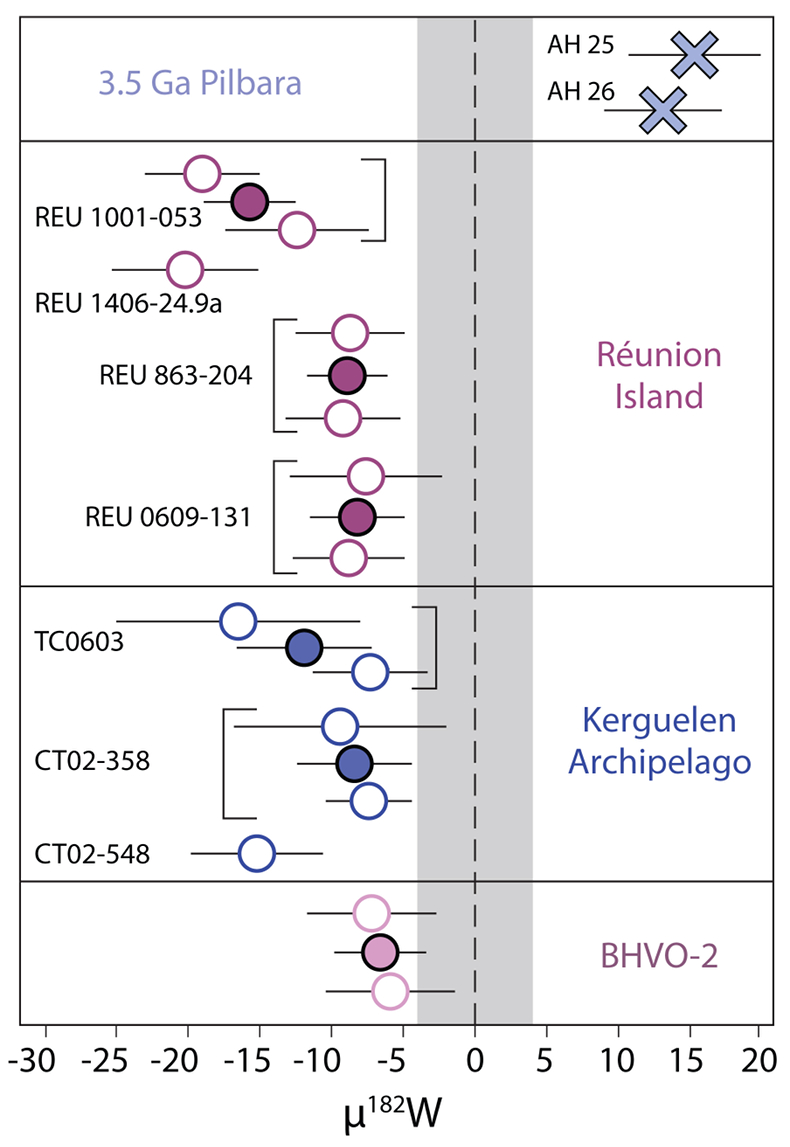
Figure 1 182W/184W data obtained in this study shown as µ182W values. Open symbols are individual analysis of samples and filled symbols show the average of the different duplicates. Errors on individual measurements shown are 2 standard error (2 s.e.) and propagated uncertainties are shown for averages. The shaded area represents the reproducibility obtained (2 s.d.) on repeated measurements of the Alfa Aesar W standard.
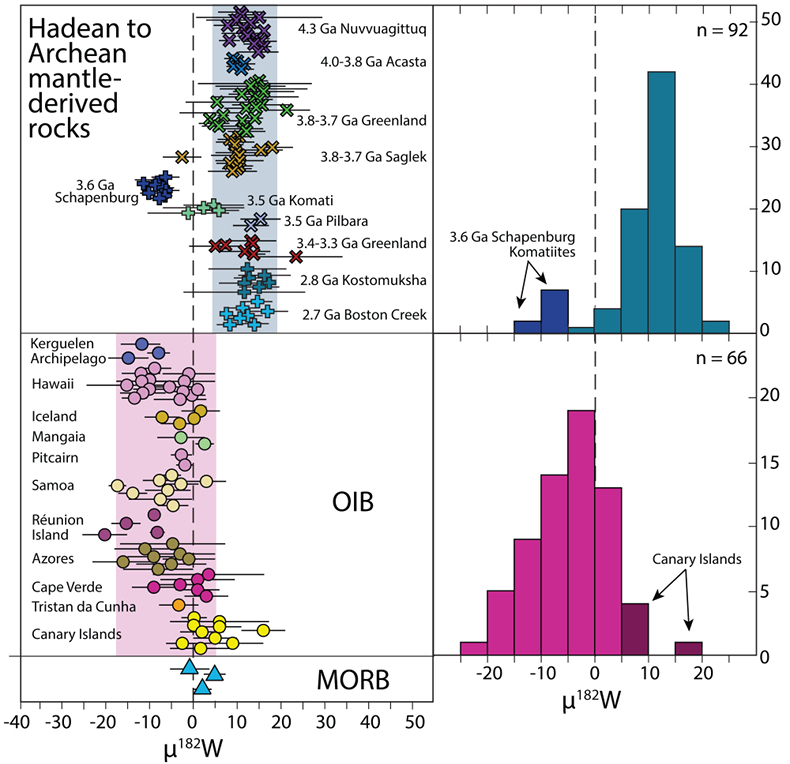
Figure 2 Compilation of all existing 182W/184W data shown as µ182W values. Hadean and Archean mantle-derived rocks are organised in order of their age, with the oldest at the top and the youngest at the bottom. Shaded areas show the average µ182W values ± 2 s.d. for Hadean-Archean and OIB samples. OIB: Ocean Island Basalts. MORB: Mid-Ocean Ridge Basalts. Data sources: Willbold et al., 2011
Willbold, M., Elliott, T., Moorbath, S. (2011) The tungsten isotopic composition of the Earth’s mantle before the terminal bombardment. Nature 477, 195.
, 2015Willbold, M., Mojzsis, S.J., Chen, H.W., Elliott, T. (2015) Tungsten isotope composition of the Acasta Gneiss Complex. Earth and Planetary Science Letters 419, 168-177.
; Touboul et al., 2012Touboul, M., Puchtel, I.S., Walker, R.J. (2012) 182W evidence for long-term preservation of early mantle differentiation products. Science 335, 1065-1069.
, 2014Touboul, M., Liu, J., O'Neil, J., Puchtel, I.S., Walker, R.J. (2014) New insights into the Hadean mantle revealed by 182W and highly siderophile element abundances of supracrustal rocks from the Nuvvuagittuq Greenstone Belt, Quebec, Canada. Chemical Geology 383, 63-75.
; Liu et al., 2016Liu, J., Touboul, M., Ishikawa, A., Walker, R.J., Pearson, D.G. (2016) Widespread tungsten isotope anomalies and W mobility in crustal and mantle rocks of the Eoarchean Saglek Block, northern Labrador, Canada: Implications for early Earth processes and W recycling. Earth and Planetary Science Letters 448, 13-23.
; Puchtel et al., 2016Puchtel, I.S., Blichert‐Toft, J., Touboul, M., Horan, M.F., Walker, R.J. (2016) The coupled 182W-142Nd record of early terrestrial mantle differentiation. Geochemistry, Geophysics, Geosystems 17, 2168-2193.
, 2018Puchtel, I.S., Blichert-Toft, J., Touboul, M., Walker, R.J. (2018) 182W and HSE constraints from 2.7 Ga komatiites on the heterogeneous nature of the Archean mantle. Geochimica et Cosmochimica Acta 228, 1-26.
; Rizo et al., 2016aRizo, H., Walker, R.J., Carlson, R.W., Horan, M.F., Mukhopadhyay, S., Manthos, V., Francis, D., Jackson, M.G. (2016a) Preservation of Earth-forming events in the tungsten isotopic composition of modern flood basalts. Science 352, 809-812.
,bRizo, H., Walker, R.J., Carlson, R.W., Touboul, M., Horan, M.F., Puchtel, I.S., Boyet, M., Rosing, M.T. (2016b) Early Earth differentiation investigated through 142Nd, 182W, and highly siderophile element abundances in samples from Isua, Greenland. Geochimica et Cosmochimica Acta 175, 319-336.
; Dale et al., 2017Dale, C.W., Kruijer, T.S., Burton, K.W. (2017) Highly siderophile element and 182W evidence for a partial late veneer in the source of 3.8 Ga rocks from Isua, Greenland. Earth and Planetary Science Letters 458, 394-404.
; Mundl et al., 2017Mundl, A., Touboul, M., Jackson, M.G., Day, J.M., Kurz, M.D., Lekic, V., Helz, R.T., Walker, R.J. (2017) Tungsten-182 heterogeneity in modern ocean island basalts. Science 356, 66-69.
; Kruijer and Kleine, 2018Kruijer, T.S., Kleine, T. (2018) No 182W excess in the Ontong Java Plateau source. Chemical Geology 485, 24-31.
; Mei et al., 2018Mei, Q.F., Yang, J.H., Yang, Y.H. (2018) An improved extraction chromatographic purification of tungsten from a silicate matrix for high precision isotopic measurements using MC-ICPMS. Journal of Analytical Atomic Spectrometry 33, 569-577.
; Reimink et al., 2018Reimink, J.R., Chacko, T., Carlson, R.W., Shirey, S.B., Liu, J., Stern, R.A., Bauer, A.M., Pearson, D.G., Heaman, L.M. (2018) Petrogenesis and tectonics of the Acasta Gneiss Complex derived from integrated petrology and 142Nd and 182W extinct nuclide-geochemistry. Earth and Planetary Science Letters 494, 12-22.
; and this study.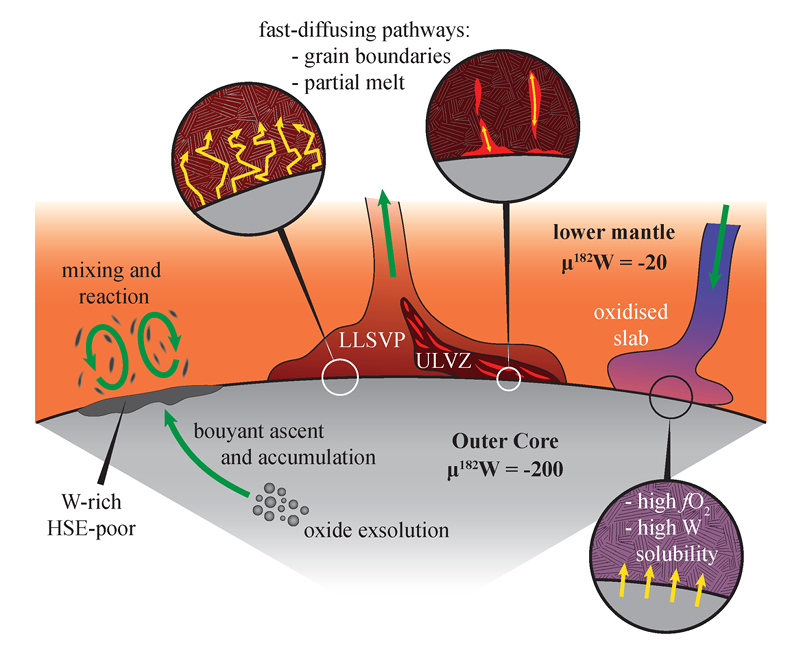
Figure 3 Schematic cartoon showing possible processes for core-mantle chemical interaction.


